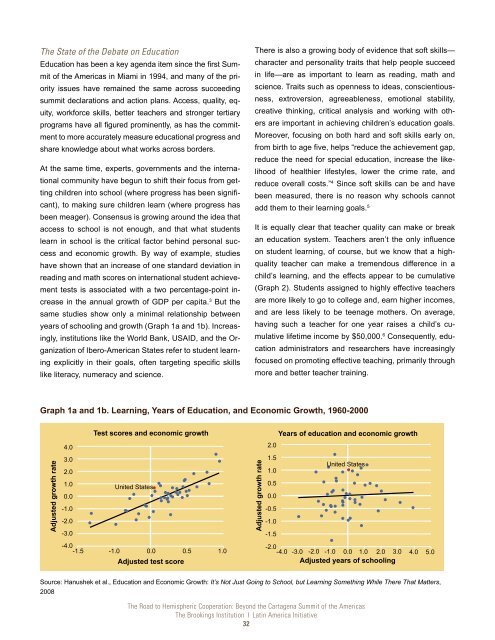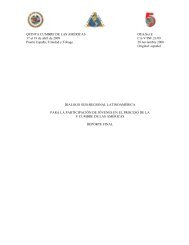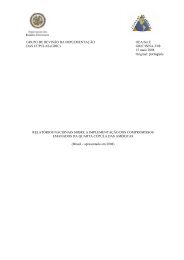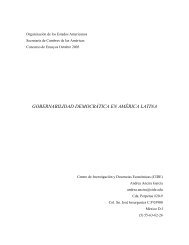The Road to Hemispheric Cooperation: Beyond the Cartagena
The Road to Hemispheric Cooperation: Beyond the Cartagena
The Road to Hemispheric Cooperation: Beyond the Cartagena
You also want an ePaper? Increase the reach of your titles
YUMPU automatically turns print PDFs into web optimized ePapers that Google loves.
<strong>The</strong> State of <strong>the</strong> Debate on Education<br />
Education has been a key agenda item since <strong>the</strong> first Summit<br />
of <strong>the</strong> Americas in Miami in 1994, and many of <strong>the</strong> priority<br />
issues have remained <strong>the</strong> same across succeeding<br />
summit declarations and action plans. Access, quality, equity,<br />
workforce skills, better teachers and stronger tertiary<br />
programs have all figured prominently, as has <strong>the</strong> commitment<br />
<strong>to</strong> more accurately measure educational progress and<br />
share knowledge about what works across borders.<br />
At <strong>the</strong> same time, experts, governments and <strong>the</strong> international<br />
community have begun <strong>to</strong> shift <strong>the</strong>ir focus from getting<br />
children in<strong>to</strong> school (where progress has been significant),<br />
<strong>to</strong> making sure children learn (where progress has<br />
been meager). Consensus is growing around <strong>the</strong> idea that<br />
access <strong>to</strong> school is not enough, and that what students<br />
learn in school is <strong>the</strong> critical fac<strong>to</strong>r behind personal success<br />
and economic growth. By way of example, studies<br />
have shown that an increase of one standard deviation in<br />
reading and math scores on international student achievement<br />
tests is associated with a two percentage-point increase<br />
in <strong>the</strong> annual growth of GDP per capita. 3 But <strong>the</strong><br />
same studies show only a minimal relationship between<br />
years of schooling and growth (Graph 1a and 1b). Increasingly,<br />
institutions like <strong>the</strong> World Bank, USAID, and <strong>the</strong> Organization<br />
of Ibero-American States refer <strong>to</strong> student learning<br />
explicitly in <strong>the</strong>ir goals, often targeting specific skills<br />
like literacy, numeracy and science.<br />
<strong>The</strong>re is also a growing body of evidence that soft skills—<br />
character and personality traits that help people succeed<br />
in life—are as important <strong>to</strong> learn as reading, math and<br />
science. Traits such as openness <strong>to</strong> ideas, conscientiousness,<br />
extroversion, agreeableness, emotional stability,<br />
creative thinking, critical analysis and working with o<strong>the</strong>rs<br />
are important in achieving children’s education goals.<br />
Moreover, focusing on both hard and soft skills early on,<br />
from birth <strong>to</strong> age five, helps “reduce <strong>the</strong> achievement gap,<br />
reduce <strong>the</strong> need for special education, increase <strong>the</strong> likelihood<br />
of healthier lifestyles, lower <strong>the</strong> crime rate, and<br />
reduce overall costs.” 4 Since soft skills can be and have<br />
been measured, <strong>the</strong>re is no reason why schools cannot<br />
add <strong>the</strong>m <strong>to</strong> <strong>the</strong>ir learning goals. 5<br />
It is equally clear that teacher quality can make or break<br />
an education system. Teachers aren’t <strong>the</strong> only influence<br />
on student learning, of course, but we know that a highquality<br />
teacher can make a tremendous difference in a<br />
child’s learning, and <strong>the</strong> effects appear <strong>to</strong> be cumulative<br />
(Graph 2). Students assigned <strong>to</strong> highly effective teachers<br />
are more likely <strong>to</strong> go <strong>to</strong> college and, earn higher incomes,<br />
and are less likely <strong>to</strong> be teenage mo<strong>the</strong>rs. On average,<br />
having such a teacher for one year raises a child’s cumulative<br />
lifetime income by $50,000. 6 Consequently, education<br />
administra<strong>to</strong>rs and researchers have increasingly<br />
focused on promoting effective teaching, primarily through<br />
more and better teacher training.<br />
Graph 1a and 1b. Learning, Years of Education, and Economic Growth, 1960-2000<br />
Adjusted growth rate<br />
Test scores and economic growth Years of education and economic growth<br />
4.0<br />
2.0<br />
3.0<br />
2.0<br />
1.5<br />
1.0<br />
United States<br />
1.0<br />
United States<br />
0.5<br />
0.0<br />
0.0<br />
-1.0<br />
-0.5<br />
-2.0<br />
-1.0<br />
-3.0<br />
-1.5<br />
-4.0<br />
-1.5 -1.0 0.0 0.5 1.0<br />
-2.0<br />
-4.0 -3.0 -2.0 -1.0 0.0 1.0 2.0 3.0 4.0 5.0<br />
Adjusted test score<br />
Adjusted years of schooling<br />
Source: Hanushek et al., Education and Economic Growth: It’s Not Just Going <strong>to</strong> School, but Learning Something While <strong>The</strong>re That Matters,<br />
2008<br />
<strong>The</strong> <strong>Road</strong> <strong>to</strong> <strong>Hemispheric</strong> <strong>Cooperation</strong>: <strong>Beyond</strong> <strong>the</strong> <strong>Cartagena</strong> Summit of <strong>the</strong> Americas<br />
<strong>The</strong> Brookings Institution ❘ Latin America Initiative<br />
32<br />
Adjusted growth rate








